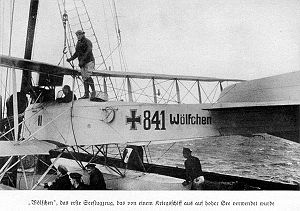Friedrichshafen FF.33 Video - Picture

|
|
Friedrichshafen FF.33
FF.33

Picture - The "Wilfchen" (Little Wolf) aboard SMS Wolf (auxiliary cruiser).
Role: Fighter
Manufacturer: Flugzeugbau Friedrichshafen GmbH
First flight: 1914
Introduced: 1914
Primary user: Kaiserliche Marine
Number built: FF.33E: 180
FF.33L: 135
Friedrichshafen FF.33 was a German single-engined amphibious reconnaissance biplane designed by Flugzeugbau Friedrichshafen in 1914.
Versions
FF.33
Initial production version powered by a Mercedes D.II engine, six built
FF.33b
FF.33 with pilot and observers positions reversed, additional observers-operated machine-gun and powered by 119 kW (160 hp) Maybach inline piston engine, five built.
FF.33e
Main production reconnaissance variant powered by a Benz B.III inline engine, longer twin floats, under tail central float removed, and radio transmitter instead of armament, about 180 built.
FF.33f
Scout/Fighter version based on FF.33e with reduced span wings and reduced length but fitted with a machine-gun on a pivoted mount, five built.
FF.33h
FF.33f with aerodynamic refinements, and duplication of wing-bay bracing cables as a safeguard if the observer has to fire his machine-gun forward through the wings, about 50 built.
FF.33j
FF.33e with aerodynamic refinements and the provision of a radio transmitter and receiver.
FF.33l
Main production scout/fighter version, with further aerodynamic improvements and a fixed machine gun, about 130 built
FF.33s
dual-control trainer version
FF.39
Refined version of the FF.33e with a 149 kW (200 hp) Benz Bz.IV engine, 14 built.
FF.49c
Further improved FF.39 with strengthened structures, balanced controls, a radio receiver and transmitter, machine-gun for observer, over 200 built.
FF.49b
Bomber variant of the FF.49c, crew positions reversed, deletion of observers machine-gun and provision to carry a light bombload, 15 built.
FF.59a
Development aircraft based on FF.39 with different tail, one built.
FF.59b
Development aircraft based on FF.39 with different tail, one built.
FF.59c
FF.39 with modified tail unit, wing interplane struts moved outwards and inner-bay bracing wires removed.
C.I
A landplane version of the FF.33l with wheeled landing gear, one built.
Operators
Bulgaria
Four FF.33Es and four FF.33Ls stationed since 1916 at the German Naval Air Station Peynerdjik near Varna on the Black Sea were transferred in June 1918 to the Bulgarian Navy. They were scrapped in 1920 in accordance with the clauses of the Peace Treaty.
Denmark
Finland
Finnish Air Force purchased two FF.33Es from Germany in February 1918. The first one arrived on April 20, 1918 to Vaasa and the other one in the summer of 1918. The aircraft wore the German designation numbers 1999 and 1998, which were changed into the FAF designation numbers F16 and F24 (later S58/18 and S73/18). Another FF.33E was purchased from the Germans in Estonia on November 26, 1918. The type was in FAF service between 1918-1923.
German Empire
Kaiserliche Marine
Netherlands
Poland
Polish Navy operated three: FF.33E, FF.33H, FF.33L in 1920-1922
Sweden
Swedish Navy
Specifications (FF.33E)
Data from Thulinista Hornetiin
General characteristics
Crew: 2
Length: 10.22 m (33 ft 6 in)
Wingspan: 16.60 m (54 ft 6 in)
Height: 3.75 m (12 ft 4 in)
Max takeoff weight: 1,550 kg (3,412 lb)
Powerplant: 1x— Benz Bz.III inline engine, 112 kW (150 hp)
Performance
Maximum speed: 110 km/h (60 kn, 68 mph)
Endurance: 4-5 hours
Armament
8 x— 12 kg (26.4 lb) bombs
Friedrichshafen FF.33s history
Timo Heinonen (1992). Thulinista Hornetiin - 75 vuotta Suomen ilmavoimien lentokoneita. Tikkakoski: Keski-Suomen ilmailumuseo. ISBN 9519568824.
Friedrichshafen FF.33 Pictures
More aircraft.
Source: WikiPedia